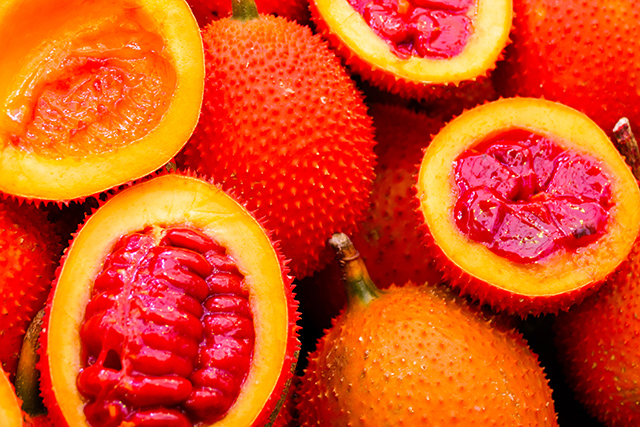Gac seeds exhibit anti-inflammatory action
05/06/2019 // Evangelyn Rodriguez // Views
Tags: alternative medicine, anti-inflammatory, food cures, food is medicine, food science, functional food, gac fruit, gac seeds, goodfood, goodhealth, goodmedicine, Momordica cochinchinensis, Momordicae Semen, natural cures, natural medicine, prevention, research, saponins, superfoods, TCM, traditional Chinese medicine

- The seeds (Momordicae Semen) of the gac fruit (Momordica cochinchinensis) are used in traditional Chinese medicine to treat boils, rheumatic pain, muscle spasm, hemorrhoids, and hemangiomas.
- The researchers used ethanol as extraction solvent and successfully identified three triterpenoidal saponins (1–3). They used RAW264.7 cells to assess their anti-inflammatory activities.
- The researchers also used overexpression experiments and immunoblot analyses with Src and Syk to confirm the molecular targets of the saponins.
- Among the three saponins, compound 3, also known as momordica saponin I, reduced the production of nitric oxide (NO) in LPS-activated RAW264.7 cells without inducing cytotoxicity.
- Momordica saponin I also decreased the mRNA levels of inducible NO synthase (iNOS) and cyclooxygenase (COX)-2.
- In addition, momordica saponin I inhibited the translocation of subunits of the transcription factor NF-KB, p65 and p50, into the nucleus.
- Momordica saponin I treatment also decreased the phosphorylation levels of inflammatory signaling proteins (IKBA, Src, and Syk), which are known to be upstream regulatory molecules of p65.
Based on these results, the researchers concluded that the momordica saponin I in gac fruit is a bioactive immunomodulatory agent that could be beneficial in treating inflammatory diseases.
Journal Reference:
Yu JS, Kim JH, Lee S, Jung K, Kim KH, Cho JY. SRC/SYK-TARGETED ANTI-INFLAMMATORY ACTIONS OF TRITERPENOIDAL SAPONINS FROM GAC (MOMORDICA COCHINCHINENSIS) SEEDS. The American Journal of Chinese Medicine. 2017;45(03):459–473. DOI: 10.1142/s0192415x17500288
Related Topics
alternative medicine anti-inflammatory food cures food is medicine food science functional food gac fruit gac seeds goodfood goodhealth goodmedicine Momordica cochinchinensis Momordicae Semen natural cures natural medicine prevention research saponins superfoods TCM traditional Chinese medicineLatest News
Related News
11/21/2023 / By Arsenio Toledo
11/21/2023 / By Evangelyn Rodriguez
11/21/2023 / By Zoey Sky
11/20/2023 / By Arsenio Toledo
11/17/2023 / By Zoey Sky
11/15/2023 / By Kevin Hughes
Take Action:
Support Natural News by linking to this article from your website.
Permalink to this article:
Copy
Embed article link:
Copy
Reprinting this article:
Non-commercial use is permitted with credit to NaturalNews.com (including a clickable link).
Please contact us for more information.
Please contact us for more information.






















